Tour of Commonwealth Solar sites:
This is a photo-intensive page so please have some patience while all
the photos load ...
Many solar websites will feature beautiful buildings ... from Germany
or
other scandanavian countries.
While CommonWealth Solar LLC has indeed consulted
for remote science research sites in Gabon, Africa - the vast majority
of our work since 1975 has been in Virginia.

Here are two of our installers goofing off and mimicing "The Price Is
Right", celebrating completion of this 3.3kw Photo Voltaic (PV)
Solar system because it
was
such a beautiful day in March 2009.

This March 2009 install was in one of the the most beautiful
houses we have had the honor of bringing closer to the freedom of
energy
efficiency and alternative energy. The Shugars house.
This is a museum quality rehabilitation of a "Fan" neighborhood house
in downtown Richmond, Va.
While certainly more beautiful than many houses, it is an example of
the current 2009 trend: solar in increasingly urban neighborhoods.
Alternative energy has formerly been more common in rural settings
where power has always been insecure.

However recently interest has grown within urbanized areas in the
environmental benefits as well as security aspects
This system is a "Grid Interactive" system that has very low
maintenance batteries to carry the system for several days if the grid
goes down.
While the grid is working,
excess production is sold back to the power company. Furthermore Solar Renewable Energy Certificates
(SRECs) can also be sold over the power grid to other power producers
or users of "Green Tags" and bring
you quarterly cash!
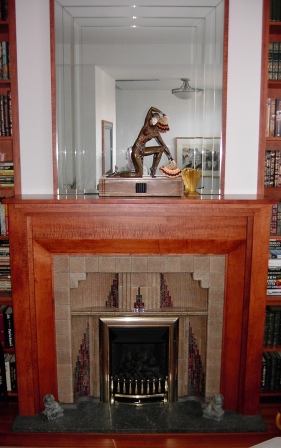
This is the opposite of a "Grid Tied"
systems that shut down when the main power grid goes down.
Both Grid Tied and Grid Interactive systems pump excess power into the
electrical grid for others to use and pay for.
This is convenient since a lot of peak power consumption is during the
sunniest and hottest days when air conditioning systems are working
full time.
Solar alternative energy is also more affordable now as the costs are
offset by tax breaks and cash flow available from Solar Renewable
Energy Certificates (SRECs).
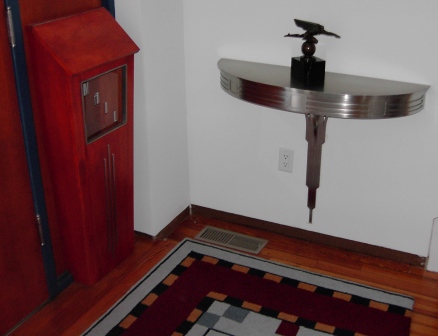
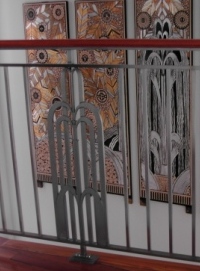
This house has already implemented many of the reasonable efficiency
efforts that make a solar Photo Voltaic system able to support this
house for 3 or 4 days even in grey weather and indefinitely with
careful thoughtful use and sunny days.

For example, when the addition with a basement add-on was built, you
can see here that insulation was applied to the outside of the basement
brickwork.
The brickwork is very effectively pointed. That is, the mortar is in
better shape than many houses in this century plus old neighborhood.
Even so, our blower door test did find a few leaks that were left
behind in hidden places and not obvious until after we tested the shell
of the house.
Even such an excellent job of rehabilitiation will often leave gaps in
the building's shell and the only way to know for sure is to run a
depressurization test with a profressional energy audit.
In this case, an energy audit helps find that last significant loss of
energy that will dramatically improve the effectiveness of alternative
solar energy production.
The Davis House
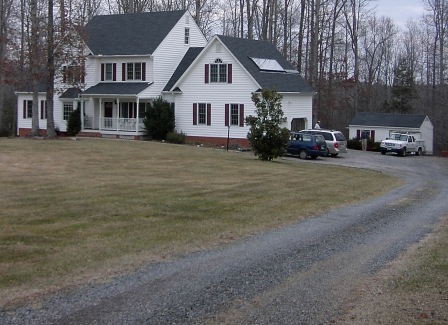
The davis house in western Hanover, Va. had their crawl space sealed
and this really helped
with the cold floor under the kitchen!
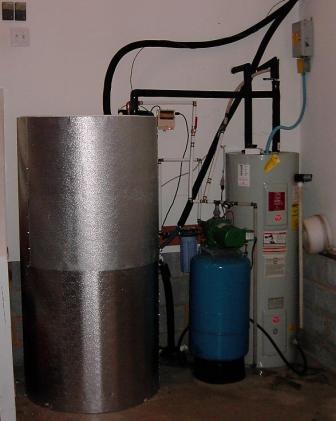
Also the Kitchen table was in a bay that overhung beyond the
foundation.
Foam panels underneath really helped making breakfast more enjoyable.
So after some reasonable conservation,on to the solar thermal system.
The tank is mounted next to their hot water heater in the garage so of
course we put the 12 foot by 4 panel on the garage. We flashed the
panel so future roof maintenance will be easier. See
more about roof flashing at Commonwealth Solar's Appendix page.

Here's a shot of Davis's tank being assembled on-site. This is very
handy when space is tight. Even when the access is wide open such
as here, these tanks can be customized to the energy consumption
patterns of its installed site. These are large tanks meant to take
advantage of the efficiency of time. The tank within a tank method
provides nearly 100% efficient transfer of heat from the water in the
solar panels to the potable water for your drinkind and showering in
the inner tank.
The reason for nearly 100% efficient transfter is that this method
takes advantage of time.
Given enough time, the entire universe will be one temperature. In a
considerably shorter length of time, the heat will almost all go from
the panel water stored in the outer tank to your drinking and shower
water in that inner tank.
As you can see above, then that solar preheated water goes through
insulated pipes to the main electric tank which now functions as backup
heat for those occasional 4 grey days in a row. Even on overcast days, the
tank will often increase the well water from some 40 degrees to 80
degrees so even on grey days, it saves them money on heating water. On
several consecutive sunny days, the system actually has to cut off with
a "high limit switch" to avoid going over 160 degrees !
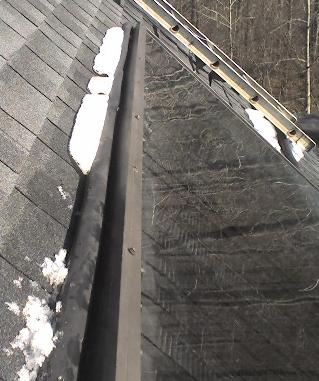 Here you can see why we
flashed their roof.
, during our installation Winter 2009, snow
accumulated on the
top. The flashing was installed after this picture and will no longer
lay trapped. Leaves also will no longer be trapped. Here you can see why we
flashed their roof.
, during our installation Winter 2009, snow
accumulated on the
top. The flashing was installed after this picture and will no longer
lay trapped. Leaves also will no longer be trapped.
One of the other advantages of a "drain back" system is that it is much
less likely that there will be water in the solar panels to freeze and
do damage.
Drain back systems also rarely if ever suffer from "Stagnation" damage
from sitting in the sun when the pump cuts off for any
reason.
Some of those reasons are that the power has gone out and the pump is
not running. Or the building is on standby awaiting sale or rehab
repairs. Or perhaps it is not being used during the hottest months,
(say the building users went on vacation in August) or if it were a
commercial building, like a school Administration building, the usage
drops to almost nothing in August.
The Burger House
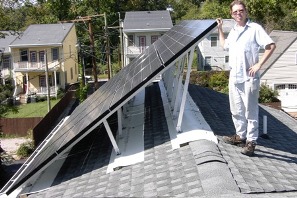
The first PV system in Oregon Hill, a neighborhood just south of
Virginia Commonwealth University in downtown Richmond, Va.
Please note the white metal flashing so that future roof shingle repair
and maintenance can be done around the PV system.
We painted silver
coating on the roof shingles close to the system but not underneath it
to protect more of the roof shingles from the Sun's Ultra-Violet (UV)
rays that destroy them.
This is another "Grid Interactive" system that has batteries. This
system was installed in a power grid that was originally built for an
older neighborhood of lower electrical power consumption. These are
mostly 1880s vintage uninsulated wood frame houses with mostly natural
draft gas powered heaters that consume a lot of gas, but not much
electricity! Very convenient when the power goes out, but not easy on
the wallet. The power grid is suffering because of many rehabs and new
houses recently added or updated that now have heat pumps and modern
appliances such as clothes dryers, microwaves, computers and big screen
TVs.
As a result, we found that the quality of the electric power was so
variable that his house often ends up running on the PV panels and
batteries even though the grid is not technically "down". We found on
one visit that the difference between "Leg 1" and "Leg2 was over
10volts. Each "Leg" is half of the 240v that most houses receive from
the power pole. Each of those legs is a "phase" that is 120 volts that
most of your consumer devices plug into.
We also found that one of those legs drifted down to 105 volts, which
tripped the system to disconnect from a grid suffering from BrownOut.
This variability is great for old incandescent light bulbs as they glow
dimmer and dimmer and thus last longer, but if comfort and productivity
with good lighting and happy computers are your goal, an older power
grid creaking under the load of new development can really stress
modern electronics out!
A Grid Interactive PV system like this can help with security in older
grid areas. The downside was that this system often produced more power
in an afternoon than the house consumed and the batteries were fully
charged. This means that the panels actually stopped putting energy out
becaues there was no where to send the energy! The grid was too
unstable to accept the energy. This is something you might want to
consider if you choose an "Grid Tied" system that have no batteries.
The bottom line is that Grid
Interactive systems WITH
batteries provide more security even when the grid does not appear to
be "down" but just is not up to the strain of new development and big
screen TVs.
Some of the older systems
... that have been installed for YEARS and/or years ago!
After all, Ken Schaal has been working on solar systems since 1976.
Bob's house ...

Bob is one of three original thermal solar systems installed in 1976 in
Ashland, Virginia a block from the railroad tracks.
In 1999 the original fiberglass glazed collectors are replaced with
glass and remounted higher on the roof when the sunroom was added.
We reused the same tank.
Originally this system was a drain DOWN. In drain down there is a
pressure valve to the cold water supply. The problem is that this
automatic valve is a failure point and thus the system can fail to
drain down at night and the panels can freeze in the winter or even at
40 degrees due to "night sky radiation".
This system was later converted to Drain BACK system in 1978.
In 1999 when sunroom addition was added, we moved the panels to the
upper roof with better collectors.
Bob also had a hydrostove installed. This allowed burning wood to back
up the solar on a series of grey days using a Tube and Shell heat
exchanger.
Bob had an oil boiler at that time that also supplied Domestic Hot
Water (DHW). We repurposed that heat exchanger.
Later still, the oil boiler was converted to a condensing natural gas
Munchkin boiler that is over 95% efficient for baseboard heat in four
zones.
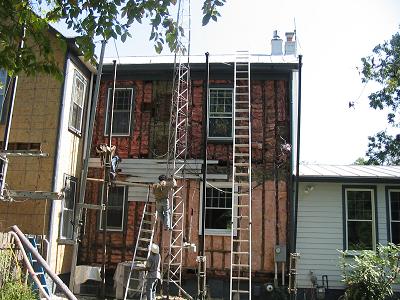
Bob also took the siding off to put up hardiplank because he was tired
of
repainting.
The dirty insulation shows air flow THROUGH the fiberglass insulation.
Insulation also therefore allowed moisture to come THROUGH the
insulation and the paint pops off.
The paint pops off the wooden siding when moisture from inside is
absorbed by the wood and then literally pushes the paint off the siding
as the sun drives that water out of the wood siding soaked by moving
moist air from inside!
Bob got the house resheathed and airsealed with housewrap to prevent
air infiltration and reduce popping paint.
Hardiplank siding (being cement based) also holds the paint much better.
Energy conservation and alternative energy is a PACKAGE that takes in
all factors with the house treated as a whole house system of issues.
Proof that the air leakage (expressed as the "number of air exchanges
per hour") have dropped is that the food odors linger longer! He added
an effective range hood exhaust system.
Insulation has other advantages: He noticed immediately after
insulation was blown into the cieling, walls and crawl space was lined
and insulated that the noise and vibration from passing trains was
vastly reduced.
The house is now quiet ...
En example of window insulation conservation work by Commonwealth Solar
...
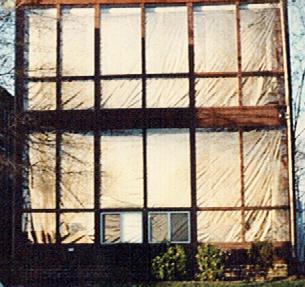
In 1981, this amazing Libby Hill house near Libby Hill Park was
featured in a Sunset Books publication entitled, "Solar Remodeling:
Passive Heating and Cooling" (page 36)
.

As you can see here, the foil unrolls down tracks to hold it in place.
This is very similar to currently available cellular shades that
Commonwealth Solar can custom design and install with side tracks.
This is just one of the two systems of this type that Commonwealth
Solar have installed.
An odd bit of corporate product history has locked this product in a
kind of ownership limbo ... but there are other possibilities.
Check our moveable window insulation page
for more ...
... more projects to come!
Return to this page regularly for
more sites and history ...
... more projects to come !
Return to this page regularly for more sites and history ...
If you have
any
further questions, please email and ask so that we know what we need to
add to this appendix !
Contact via email
Note: Last Update 06/25/2021
CommonWealth Solar, LLC
12433 Autumn Sun Lane • Ashland VA,
23005
• (804) 216 5371
|
